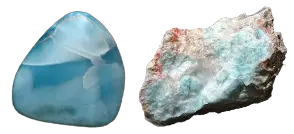 Photo of Larimar in Processed & Rough Form
Photo of Larimar in Processed & Rough Form
Larimar is a mineral with a hardness of 5 out of 10 on the Mohs scale of mineral hardness [?]. These Triclinicly structured gems are made of sodium calcium inosilicate hydroxide, their full chemical compound being NaCa2Si3O8(OH).
Larimar is a rare blue variety of pectolite found only in the Dominican Republic. Its distinctive sky-blue color comes from copper substitution in the mineral structure. Discovered in 1974, it's nicknamed "Caribbean gem" or "Dolphin stone." Used mainly in jewelry, its color can range from light sky blue to deep blue with white patterns. Mining occurs in a single mountainous region of the Dominican Republic, making it relatively.
What causes Larimar's distinctive blue coloration?
The characteristic blue color results from copper substitution within the calcium sodium silicate structure of pectolite. Color intensity variations correlate with copper concentration and oxidation state.
How do formation conditions affect pattern development?
Volcanic-hydrothermal formation conditions create distinctive flow patterns and color zonation. Temperature, pressure, and cooling rates during crystallization determine pattern development and intensity.
What explains the limited geographical distribution?
Larimar occurs exclusively in the Dominican Republic's Barahona Province, formed under specific volcanic conditions. The unique geochemical environment required for blue pectolite formation restricts its global distribution.
How are volcanic patterns classified?
Pattern classification includes volcanic flow, cloud, and wave formations. These patterns result from crystallization during hydrothermal activity, with premium specimens showing distinct white-blue contrast.
What analytical methods verify authenticity?
Physical properties include characteristic hardness (4.5-5), specific gravity (2.84-2.90), and distinctive UV fluorescence. Raman spectroscopy confirms pectolite structure with copper modification.
How does weathering affect specimen quality?
Natural weathering creates brown surface oxidation requiring removal during processing. Depth of mining correlates with color quality, with deeper specimens typically showing superior blue saturation.
What determines specimen grade classification?
Grading factors include color intensity, pattern distinctiveness, and matrix presence. Premium grade requires deep blue color, minimal matrix, and well-defined volcanic patterns.
The specific gravity [?] for Larimar is 2.84, its refractive index [?] is 1.59-1.65, and its double refraction [?] is 0.033.
History
Larimar was officially discovered in 1974 by Miguel Mendez and Norman Rilling on a Dominican Republic beach, though local inhabitants knew of it earlier. It was named by Mendez, combining his daughter Larissa's name with mar (sea). The Dominican government restricted mining to local artisans in 1974, and it became a significant economic resource for the region.
Industrial Usages
Due to its limited source, larimar has no significant industrial uses. It is prized for its beauty and is used exclusively in jewelry and ornamental pieces.




